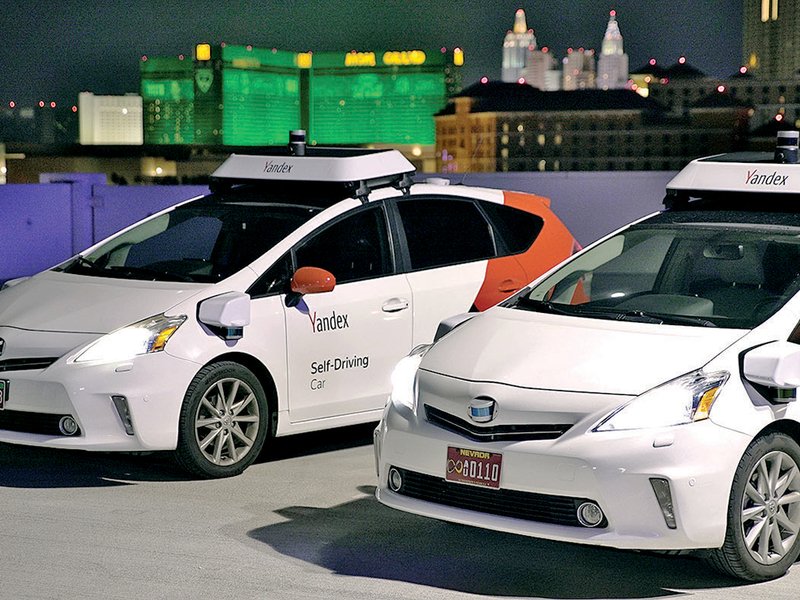
LAS VEGAS — Inside the parking garage at the Hard Rock Cafe, one of the human safety drivers from Russian self-driving tech company Yandex opens the car door and climbs aboard the Prius V for a quick ride around the city.
Today, he’s riding shotgun.
Showcases of autonomous-driving technology have become so commonplace at CES in recent years that they’ve become almost ho-hum affairs. But Yandex added a fresh twist this time, removing its human safety drivers from behind the wheel and placing them in the passenger seat instead. Without any human behind the wheel, Yandex rolled two vehicles onto public roads and delivered a week’s worth of uneventful rides through Las Vegas’ traffic-clogged arterial four-lane roadways.
This was something of a public-road milestone for these particular city streets, but Dmitry Polishchuk, head of self-driving cars at Yandex, downplayed the complexity of the moment.
“People are more polite driving here,” he said. “In Tel Aviv and Moscow, we need to be much more assertive and aggressive.”
Polishchuk knows about driving conditions in those locations. Yandex’s profile may get overshadowed by the likes of Waymo and traditional automakers in the United States, but the company has global ambitions for its self-driving technology. Along those lines, it’s operating testbeds in not just Tel Aviv and Moscow, but the Russian cities of Innopolis and Skolkovo.
Next up: the Motor City. This summer, Yandex will operate 10 cars in Detroit as part of the city’s revamped auto show.
Combining forces with Hyundai Mobis, which Yandex forged a long-term partnership with last March, the two companies will utilize Hyundai Sonatas as their vehicle platform, though the two Prius Vs used in Las Vegas will also be involved in the Detroit project.
It remains undecided whether Yandex will have its safety drivers ride in the passenger seat as in Las Vegas. A company spokesperson says Michigan’s laws would allow for such a move, but a number of safety factors will be considered before making that decision.
Regardless, there will be novel aspects of the company’s Detroit demonstrations.
Organizers from the North American International Auto Show have contracted with five companies to provide autonomous rides during the show’s scheduled June 6-21 run. The other four companies — Local Motors, Navya, Continental and AutoGuardian by Smart Cone — will all provide fixed-route service. Yandex will have designated stops, but not preset routes.
Further, all of the companies will offer rides to the public, which can be arranged via a special app being developed for the show by Moovit, a mobility-as-a-services company based in Israel.
For Yandex, the aggressiveness of its self-driving system is versatile enough that it can be tuned and tailored to fit the driving styles in a given market. The biggest change may be that it will be integrating its system on a platform and operating with partners rather than on its own.
“We’re used to doing this on our own, like we did with the Prius,” Polishchuk said. “But we’ll doing this with Hyundai Mobis, and it brings it to a really different level when you do it together with the manufacturer.”
Yandex has established an operations hub in Detroit and has begun mapping the city’s streets in preparation for the summer event.
In some fashion, the presence in Las Vegas helped the company adjust its systems to account for some differences in driving behavior and traffic laws.
For example, in Russia, a blinking yellow indicates a traffic light is broken. In the United States, it indicates drivers should proceed with caution.
Yandex has roughly 110 vehicles in its fleet, about 85 of those committed to operations in Russia, where the company hopes to soon remove safety drivers entirely from its Innopolis self-driving taxi operations. Polishchuk says Yandex is hoping to get regulatory approval for that this year. That would be a landmark event for a self-driving program that has rapidly grown since its founding in 2017.
With 1.6 million miles now driven in autonomous mode, he said, “the amount of situations we’ve faced and the situations we can now handle are way more advanced.”
Still, like the rest of the industry, Polishchuk acknowledges that launching self-driving technology at mass scale is a ways off. He says it depends on the operating environment.
“There are certain areas where this tech could already be deployed and it will be at the level of a human driver,” he said.
“I think we’ll see some deployments in the easier scenarios within the year. But there are environments where people ignore lane markings, that are more like guidance; it’s difficult to predict behavior. And this will take two to three years from now to be at the level of a human driver.”